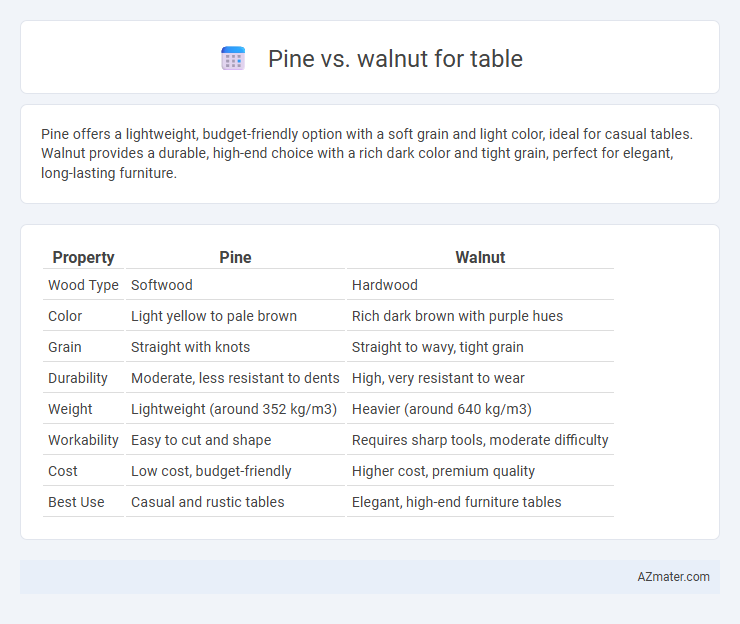Pine offers a lightweight, budget-friendly option with a soft grain and light color, ideal for casual tables. Walnut provides a durable, high-end choice with a rich dark color and tight grain, perfect for elegant, long-lasting furniture.
Table of Comparison
| Property | Pine | Walnut |
|---|---|---|
| Wood Type | Softwood | Hardwood |
| Color | Light yellow to pale brown | Rich dark brown with purple hues |
| Grain | Straight with knots | Straight to wavy, tight grain |
| Durability | Moderate, less resistant to dents | High, very resistant to wear |
| Weight | Lightweight (around 352 kg/m3) | Heavier (around 640 kg/m3) |
| Workability | Easy to cut and shape | Requires sharp tools, moderate difficulty |
| Cost | Low cost, budget-friendly | Higher cost, premium quality |
| Best Use | Casual and rustic tables | Elegant, high-end furniture tables |
Introduction to Pine and Walnut Wood
Pine wood is a softwood known for its light color, straight grain, and affordability, making it a popular choice for furniture like tables due to its ease of work and availability. Walnut wood, a hardwood prized for its rich, dark brown tones and durability, offers a luxurious appearance and superior strength for long-lasting table construction. Both woods differ significantly in hardness, grain patterns, and finishing options, affecting the table's aesthetic and functional qualities.
Key Differences Between Pine and Walnut
Pine tables are lightweight with a pale yellow to light brown tone, offering affordability and easy customization due to its soft texture. Walnut tables feature a rich, dark brown color with intricate grain patterns, prized for durability and a luxurious appearance in high-end furniture. Pine is prone to dents and scratches, whereas walnut provides superior resistance and ages gracefully with a smooth finish.
Appearance and Grain Comparison
Pine tables feature a light, creamy color with a softer, more uniform grain that often includes visible knots, giving a rustic and casual appearance ideal for cozy interiors. Walnut tables boast a rich, deep brown hue with a complex, pronounced grain pattern featuring bold swirls and streaks, which lends an elegant, sophisticated look perfect for formal settings. Comparing grain textures, pine offers a smoother, straighter grain, while walnut's grain is intricate and varied, enhancing the visual depth and luxury of the furniture.
Durability and Hardness
Walnut offers superior durability and hardness compared to pine, making it ideal for high-traffic tables that require resistance to dents and scratches. Pine is a softer wood prone to dents and wear over time, which may necessitate more frequent maintenance. Walnut's Janka hardness rating averages around 1,010, while pine ranges between 380 and 870, indicating walnut's enhanced strength and longevity for table surfaces.
Cost and Availability
Pine tables are generally more affordable and widely available due to the wood's fast growth and abundance, making it a cost-effective choice for budget-conscious buyers. Walnut, known for its rich color and durability, tends to be more expensive and less readily available because it grows slower and is considered a premium hardwood. Availability of walnut can also be seasonal or regional, impacting its price and accessibility compared to the consistently stocked pine.
Suitability for Table Construction
Pine offers lightweight durability and ease of machining, making it suitable for casual or rustic table construction with a softer surface prone to dents. Walnut provides superior hardness, rich grain patterns, and long-lasting strength, ideal for high-end, elegant tables requiring durability and resistance to wear. Selecting between pine and walnut depends on desired aesthetics, budget, and table usage intensity.
Maintenance Requirements
Pine tables require more frequent maintenance due to their softer wood, which is prone to scratches and dents, necessitating regular sealing or waxing to protect the surface. Walnut tables, made from hardwood, offer greater durability and resist wear with minimal upkeep, often requiring only occasional polishing to maintain their rich finish. Both woods benefit from wiping spills promptly, but walnut generally demands less intensive care over time.
Environmental Impact and Sustainability
Pine tables have a lower environmental impact due to the tree's rapid growth rate and renewable availability, making pine a more sustainable choice compared to walnut. Walnut trees grow more slowly, requiring longer periods to mature, which can lead to greater depletion of natural resources and increased environmental strain. Choosing pine supports sustainable forestry practices by promoting faster replenishment and reducing carbon footprint in furniture production.
Pros and Cons of Pine Tables
Pine tables offer affordability and a light, natural aesthetic that complements rustic and casual interiors, making them ideal for budget-conscious buyers and those seeking a warm, inviting atmosphere. The soft wood of pine is easy to shape and repair but is prone to dents, scratches, and discoloration over time, limiting its durability compared to hardwoods like walnut. While pine tables require regular maintenance to prevent damage, their sustainable sourcing and ability to accept various finishes provide versatility for customization.
Pros and Cons of Walnut Tables
Walnut tables offer exceptional durability and a rich, dark grain that enhances the elegance and longevity of furniture, making them a premium choice compared to pine. They resist dents and scratches better than softer woods like pine, but their higher cost and heavier weight can be potential drawbacks for budget-conscious buyers or those needing lightweight furniture. Walnut's natural oils provide some moisture resistance, but it requires regular maintenance to preserve its finish and prevent fading over time.

Infographic: Pine vs Walnut for Table
 azmater.com
azmater.com